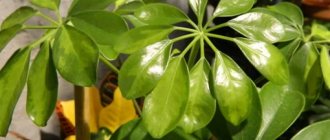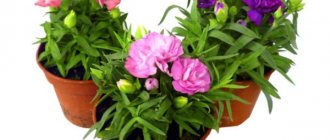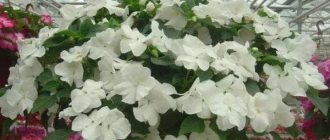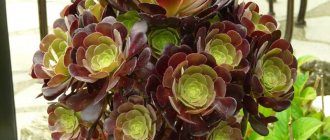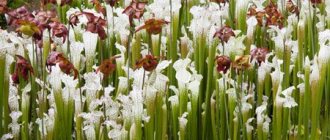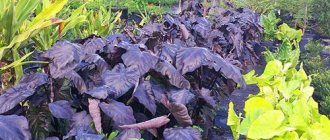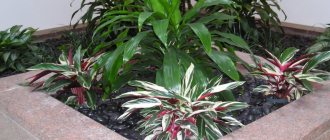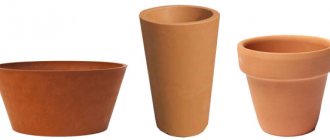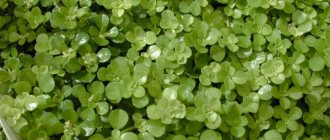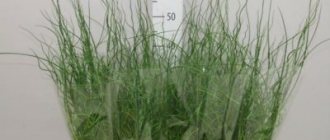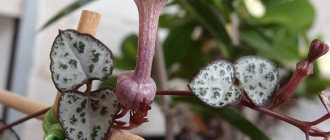A climbing relative of the pepper with succulent properties
Peperomia is a genus belonging to the Pepper family (Piperaceae). These are mainly perennial subshrubs, but herbaceous plants are also found . Both have the characteristics of succulents. The genus can boast of a very extensive representation. According to various sources, there are from 800 to 1000 species of peperomia in nature. About 50 have so far successfully adapted to the conditions of modern apartments.
Even in its natural habitat, peperomia is compact and miniature.
The name of the plant is due to its appearance. Translated from Greek “peperi” means “pepper”, omos – “similar, similar”. If you cut a leaf, a characteristic aroma will spread throughout the room.
Proponents of the teachings of Feng Shui have adopted the American nickname peperomia (“close-knit family”) and recommend that newlyweds or families whose members often disagree and cannot come to an agreement be sure to acquire at least one plant. The flower helps them “get used to” each other and smooth out conflicts, absorbing negativity and spreading the “right” vibes that cause a good mood.
Peperomia are found in almost any tropical forest. Especially many of them were found in South and Central America, Southeast Asia, and India. Under the canopy of the jungle, peperomia can exist both as an ordinary plant, receiving nutrition from the soil, and as an epiphyte, taking root on tree trunks.
The ability of peperomia to store moisture and nutrients (a quality inherent in all succulents) is evidenced by juicy, fleshy stems and thick, dense leaves. In some varieties, the distance between the leaves is minimal - the stems are literally studded with them, the plant itself resembles a rosette.
The shape of the leaves varies significantly depending on the species (they can be almost round, ovoid, heart-shaped, lanceolate, but always whole and with a short petiole). The norm is a soft short edge on both or one side, “wrinkling”. But most peperomia have smooth, shiny leaves. Even a single-color sheet plate looks very elegant, not to mention varieties with different patterns in the form of spots, stripes, and strokes.
The palette is very rich - in addition to the traditional green color, the leaves can be brownish, golden, silver, olive, dark emerald.
Peperomia is valued for its bright patterned leaves.
Peperomia often blooms, even at home, but this phenomenon often causes anxiety among gardeners, especially beginners. Her flowers are completely different from what most people associate with flowers. They are very small, collected in thin whitish curving ears, similar to mouse tails, with no petals. On a healthy adult plant, 12–15 inflorescences are formed simultaneously. If you don’t know exactly what it is, you can easily suspect some exotic disease contracted by a flower in its historical homeland.
Peperomia blooming is a rather unusual sight.
After 1.5–2 months, the cob is covered with tiny dry balls. Ripe fruits are separated from it with a light touch.
Under optimal conditions, flowering can generally last almost the entire year. Peperomia does not need a rest period.
This is what a faded peperomia looks like
The plant is compact, even miniature. The tallest peperomias do not grow more than 60 cm. The average is 35–40 cm.
The flower looks great in aquariums and bottle gardens.
Peperomia cannot boast of a growth rate (about 15 cm annually). At first it is an upright bush. As they lengthen, the stems begin to droop. If you do not prune, the old shoots located below will hang freely from the edges of the pot, and the young shoots will stick up and to the sides from the middle of the container .
Peperomia is not only beautiful, but also useful. It has been scientifically proven that it secretes phytoncides that destroy pathogenic bacteria (streptococci, staphylococci, sarcina). Their content in the air is reduced by 45–70%. Several pots of plants in the room are an excellent prevention of colds. You can also put them in the nursery - peperomia is not poisonous. There is also some evidence to suggest that it has a positive effect on the digestive system and gallbladder.
Peperomia species
Erect peperomia
A subgroup of these indoor beauties are tall, up to half a meter, and their shoots are thick and fleshy.
Peperomia obtusifolia
The elegance, amazing unpretentiousness and charm of a tropical exotic from the South American forests has enabled it to deservedly take not the last place among plants in apartments and houses, greenhouses, offices and other public areas.
The habitat of this herbaceous perennial in nature can be both tall trees and earthen cover. The dark green leaves have the shape of an ellipse with a blunt apex and petioles narrowed at the base are attached sequentially to the stems. The size of the dense, fleshy leaf plates reaches twelve centimeters in length and up to five centimeters in width.
Peperomia obtufolia is absolutely not burdensome to care for at home. She is unpretentious and hardy. You can quickly propagate it and admire the beautiful, powerful and original bush.
Peperomia magnoliaefolia
As this Brazilian beauty grows, it takes the form of a compact bush and is also called a “friendly family.” It is very similar to Peperomia obtufolia. A distinctive feature can only be called the structure of the spikelets and fruits.
Interesting! Peperomia magnoliafolia is a good air purifier and perfectly fights pathogens.
Peperomia clusiifolia
This tropical beauty is native to Venezuela. Short one-centimeter petioles are decorated with wedge-shaped leaves up to fifteen centimeters long and eight centimeters wide. The location of these dark green beauties with a reddish tint and a unique decoration - purple edging, are the lower nodes on the fleshy stem. As a result, we have a beautiful indoor plant with a rich and lush head of leaves. Its decorative properties will perfectly decorate the interior of any room or garden.
Attention! We protect Peperomia clusifolia from drafts.
Peperomia Pereskiifolia
A home flower with small green, five centimeter, oval-shaped, hard leaves, up to three centimeters wide. The leaves gather in beautiful rosettes.
Peperomia Ferreyrae
An original succulent epiphyte, it stores water well and loves to be adjacent to larger plants. Adapts perfectly to both free life and indoors. A distinctive feature is the long green leaves with light and dark shades, folded in half. The place of their original dislocation is an erect stem, forming an asterisk or snowflake.
Peperomia graveolens
A very beautiful twenty-five centimeter succulent, reminiscent of sea coral. It has long, fleshy, slightly curled light green leaves. The underside of the leaf blade is red, scarlet, burgundy or ruby.
Peperomia dolabriformis
A succulent flower with thick and succulent leaves, formed as if from circles folded in half. They are attached to a thick stem. A rosette appears at the top, resembling an asterisk. It blooms with small greenish-white flowers.
Peperomia Polybotrya
It is a rare bushy indoor flower, the height of which reaches twenty centimeters. The green, heart-shaped leaves resemble a water lily. It blooms in early summer with white flowers, collected in groups of ten on a fancy peduncle in the form of a curved candle. Blooming peperomia multitaste is very impressive due to the contrast of greenery and white flowers.
Bush-like
Varieties of this subgroup are compact flowering specimens with a lush crown, organized by soft and colorful leaves growing on very succulent stems. Blooming spike-shaped inflorescences rise above the cap of leaves.
Peperomia caperata
Peperomia caperata is native to southern Brazil. Lush and compact fifteen-centimeter bushes flaunt corrugated heart-shaped leaves of dark green, burgundy-green, violet-brown, decorated with thickened veins and a glossy waxy coating on them. During the flowering period, the lush green leaves are under clouds of snow-white spikelet inflorescences.
Peperomia Lilian
A very beautiful low-growing indoor flower. Mexico is his homeland. It got its name due to the similarity of the flowers to lilies. The appearance is absolutely identical to Peperomia corrugata. The difference emerges in the inflorescences, rising in long peduncles above the thick “cap” of glossy foliage.
Peperomia Caperata "Rosso"
The tropical forests of South America and Asia are native to this epiphytic flower with large, elongated, brightly colored leaves that form a star. The upper side of the leaf blade is dark green, and the reverse is purple-burgundy. The flowers are thick and long and please the owners for only a short time.
Silver or Watermelon Peperomia (Peperomia Argyreia)
One of the most famous varieties from Brazil and Venezuela. This striped miracle is unpretentious to grow. On purple petioles there are ten-centimeter light, silvery leaves with dark green veins. The leaf plates are arranged closely to each other, forming a bright, luxurious rosette.
Ampelous
Peperomia ampelous is increasingly found in the collections of flower lovers.
Peperomia Glabella
The interesting shape of the leaf plate, resembling a head, is directly related to the name of the flower. They are green in color, small in size, and broadly oval in shape. Often used as a decoration for flower arrangements. It can be a creeping or hanging plant. In bright light, the leaves turn pale, and the stems and petioles acquire a delicate pink color.
Peperomia rotundifolia
Peperomia rotundifolia is a South American elegant and delicate beauty with small, round, coin-shaped, one-centimeter green leaves. May be of interest to lovers of flower terrariums.
Peperomia Verticillata
A petioleless variety with gray-greenish, round or diamond-shaped leaves that are beautifully collected in whorls. Blooms in early summer, decorated with long peduncles.
Peperomia prostrata
Peperomia prostrata is native to South America and Mexico. An ampelous specimen with small one-centimeter variegated heart-shaped leaves. They have very beautifully arranged silver or bronze spots. They show off on reddish stems.
How to create suitable conditions for plants at home
The habitat of peperomia is hot and humid forests. Moreover, which is quite atypical for tropical plants, it is practically indifferent to humidity and will not require the gardener to turn the apartment into a sauna . The flower does not have a pronounced dormant period, so the conditions remain constant throughout the year.
Table: microclimate required for peperomia
| Factor | Recommendations |
| Location |
|
| Lighting |
|
| Temperature |
|
| Humidity |
|
general information
The pepper family, to which peperomia belongs, is represented on the planet by thousands of herbaceous annual, perennial and even subshrub crops.
All this diversity grows in tropical and subtropical regions; the homeland of our “pepper” is South America.
It is there, in the humid tropics, that the plant feels great on a moss bed, near rock crevices. It is interesting that even in such favorable conditions the size of the flower is small, a maximum of half a meter in height.
The fact is that the plant uses its reserves very wisely: why be long and weak if you can become “stocky”, viable, and acquire thick, succulent leaves.
By the way, flower growers observe a similar rational approach in their pets at home. ATTENTION: slow growth and not the most powerful root system allow peperomia to coexist with other indoor plants, even in the same pot. Neither citrus nor monstera will be crowded next to it, and the composition can turn out to be original.
Planting and transplanting
It is better not to disturb peperomia unless absolutely necessary. Therefore, only plants under 3 years old are replanted annually. Adult flowers are transferred to a new pot every 2–3 years, at the beginning of spring. The smaller the leaves, the more often the plants are replanted.
The time for transplantation has clearly come if the peperomia, without any additional alarming symptoms, almost stops growing, the roots stick out from the drainage hole. The substrate in the pot has already become excessively compacted, and the flower does not like it.
The container is selected to be low but wide, each time increasing its diameter by about 1.5 times. A too large pot is undesirable - peperomia does not have a growth rate anyway, and in this case all the energy will be spent on “developing” the new space by the root system.
The substrate is prepared so that neither air nor moisture is retained in it:
- Universal soil for succulents, leaf humus, peat chips and coarse river sand (5:2:2:2).
- Soil for palm trees or ficus and perlite or vermiculite (8:1).
- Leafy garden soil, humus, crushed coconut fiber or moss, small (1–3 mm in diameter) expanded clay (about equal parts).
However, problems with the soil can be avoided if you grow peperomia hydroponically.
Plants look very impressive in compositions that recreate their natural habitat, for example, on driftwood or in moss.
Peperomia is also great for growing in an ampelous manner.
The transplant procedure is simple:
- Fill one third of the volume of the new pot with drainage. It is advisable to add at least a few pieces of charcoal.
- Sprinkle a layer of substrate 1.5–2 cm thick on top. Lightly moisten and allow the water to absorb.
- Remove the plant from the container and place it together with the earthen lump in a new pot.
- Add soil in small portions between the flower and the walls of the pot and compact it gently. The ground should be 1–1.5 cm below the edge.
- Water the peperomia moderately again, put it in a warm place, and provide partial shade.
- After 12–15 days, you can return the pot to your “place of permanent registration.”
Video: how to transplant peperomia
Peperomia pruning and how to pinch shoots
Pruning for peperomia is not mandatory, but a desirable procedure to increase its decorativeness. Ampelous varieties, after cutting off young shoots, grow even more, which makes the flower “fluffy”. The pinching method can help you grow a more branched and taller houseplant. As a rule, erect shoots are pruned when they reach a height of 20-25 cm. Higher shoots break under the weight of their own weight. At the cut site, 2 to 4 new shoots grow. Bush plant species do not require pruning.
How to pinch peperomia shoots is described in detail in the video below:
Watch it for detailed study and confidence in the correctness of your actions.
How to properly care
Peperomia is quite unpretentious. But the plant responds gratefully to care, delighting the gardener with lush green or variegated caps of leaves.
Watering
The only thing that can cause difficulties for novice gardeners is watering. With excessive moisture, the roots of peperomia quickly rot. Therefore, it is important to find a “golden mean” and constantly adjust the intervals between procedures, based on the air temperature in the apartment and outside.
Water is poured into the pot until bubbles appear on the surface. Then wait 25–30 minutes and drain the excess from the pan. Between two waterings the soil should dry out, but not to such an extent that it begins to move away from the edges of the pot.
If in doubt, remember that peperomia, thanks to its “internal reserves,” tolerates a lack of moisture much easier than its excess . But you shouldn’t “test” the flower regularly - the leaves will begin to dry out and fall off.
For irrigation, use only water that has been standing for at least a day and heated to a temperature 2–3 ºС higher than it is now in the room. If there is no soft melt or rain water, add a few granules of citric acid to regular tap water. It neutralizes excess chlorine and fluoride.
Top dressing
Fertilizers are applied only during the active growing season, from approximately mid-March to the end of October every 15–20 days. Any liquid mineral complex designed specifically for succulents or decorative leafy indoor plants is suitable. The concentration recommended by the manufacturer is reduced by 1.5–2 times.
If you are not satisfied with the condition of the flower in winter, you can apply fertilizer, but not more than once a month.
Pruning for simple and ampel growing
To achieve greater bushiness, pinch each peperomia shoot, removing about a fifth of the length. If you carry out the procedure regularly, the bush will become almost spherical.
In peperomia grown in the ampel method, on the contrary, the long shoots along the edges of the pot are not touched, and the vegetation in the center is cut off, leaving about a third of the length.
Peperomia at flowering time
During flowering, peperomia produces numerous spikelet-shaped inflorescences, somewhat similar in appearance to the color of plantain, and inconspicuous small flowers. This is where the name “rat tail plant” comes from. The inflorescence reaches a length of 6-7 cm and is a thin, slightly twisted or bent process. Flowering usually occurs in spring or summer. The appearance of the flowers varies depending on the species and variety. Some flowering species have fragrant inflorescences. At the end of the flowering period, fruits are formed, which are presented in the form of small dry berries, very easily separated from the “cob”.
A photo of a blooming indoor peperomia is offered below for your reference - appreciate the extraordinary nature of the green “pet”:
A beautiful crop for collectors, especially for those who have limited space for plant placement. In addition, it is quite unpretentious, which makes the process of growing it simple. Home indoor peperomia flowers reach a height of 50-55 cm, dwarf varieties - up to 15-20 cm. The plant is distinguished by its great species diversity. The leathery, shiny leaves can be different shades of green and have all sorts of shapes - from small and thin to fleshy and wide with a curled end. The dense, fleshy stems of tall plants can bend under their own weight as they grow.
An interesting feature of this flower is that when you lightly rub the leaf plate with warm hands, you can feel a delicate subtle aroma, somewhat similar to the smell of bell pepper.
Convince yourself of the rich variety of indoor peperomia flowers by looking at the photo below:
The images show several examples of this unusual plant.
Possible errors during cultivation
In general, peperomia react stoically to “adversities” caused by the inexperience of the grower, but their decorative effect may suffer significantly. Therefore, it is important to know what you need to do to correct your own mistakes.
Table: brown tips, spots on leaves and other consequences of improper care
| External manifestations | Probable Cause |
| The leaves, starting from the lowest ones, dry out and fall off. | The plant lacks moisture. Reduce the intervals between waterings. |
| First, the very tips, then the entire “edge” of the leaf blade turn brown and dry out. | The flower is in a draft and/or there are frequent sudden changes in air temperature in the room. |
| The leaves lose their tone and color, and gray-brown spots spread on the stems. | Rot develops due to too much watering, especially if the room is cooler than the flower needs. |
| The leaves become wrinkled, wither, and deformed. | Peperomia got sunburn. Shade the pot or find another place for it. |
| Healthy-looking leaves fall off abruptly and en masse. | The room is too cold. |
Diseases and insects dangerous to plants
The main thing a gardener should be wary of is root rot. But there are also some insects that, if not controlled, can destroy the flower.
Table: what diseases and pests does peperomia suffer from?
| Disease or pest | Symptoms | How to cope |
| Root rot | Rapidly expanding “wet” gray-brown spots appear at the base of the stems and petioles, then spreading to the leaves. The roots soften and become slimy. | Any rot is very difficult to treat. You can save a flower only if you start taking measures by detecting the disease at an early stage.
|
| Mealybug | The bottom of the leaf plate appears to be sprinkled with flour. At the same time, sticky translucent discharge appears. |
|
| Thrips | Thin short “strokes” of beige color appear on the leaves - areas of dead tissue. The leaf plate acquires a silvery tint, becomes unpleasantly sticky, and becomes deformed. |
|
| Shchitovka | The stems and leaves below are covered with almost flat, round, grayish-brown growths. The tissues around them turn yellow, dry out and die. |
|
| Nematodes | Rapidly increasing, irregularly shaped areas of dead tissue appear on the leaves. They become deformed, wither and dry out. There are dark spherical swellings on the roots. |
|
| Spider mite | The petioles of the leaves are “woven” to the stems with the thinnest, almost transparent threads, similar to a cobweb. Affected leaves dry out very quickly. |
|
Photo gallery: diseases and pests of peperomia
Special preparations are used against spider mites - acaricides.
Swellings on the roots - developing nematode larvae
It is useless to use folk remedies against the strong shell of the scale insect; they can only help as prevention
When thrips appear, you need to simultaneously fight both adults and larvae
Mealybug can destroy a plant in a short time
Root rot is a disease that can only be cured if it is noticed in time.
Reproduction
Reproduction of peperomia is a simple procedure that even a novice gardener can handle. There is no shortage of planting material.
The generative method is possible and easy
You can get peperomia seeds yourself at home.
Peperomia seeds are not difficult to obtain. Even at home, the plant readily blooms. Ripe seeds are placed in paper bags and stored in a dark, dry, cool place until March-April.
Sowing order:
- Shallow flat containers are filled with a mixture of coarse river sand and universal soil for decorative leafy indoor plants.
- The soil is watered moderately.
- The seeds are laid out on the surface of the soil and sprinkled on top with a layer of soil 1.5–2 mm thick.
- The plantings are sprayed with a spray bottle and covered with glass or plastic film, creating a greenhouse.
- The seeds are provided with bright light and a constant temperature of 24–27 ºС . Bottom heating is desirable . The greenhouse is ventilated daily for 5–7 minutes, preventing the formation of condensation and the development of rot.
- As the soil dries, spray it.
- Seedlings with 1–2 mature leaves are planted in small individual containers in a mixture of peat chips, universal soil, fertile turf and sand (2:2:1:1).
- When 5–6 leaves appear (in about six months), peperomia are transplanted into pots with a diameter of 7–8 cm and cared for as for adult plants.
Rooting cuttings
A peperomia cutting is the tip of the shoot or the middle part of the stem cleared of leaves. It is necessary to have at least one (preferably 2-3) “nodes” - points of growth. Rooting occurs on average in 8 out of 10 cases.
You can even use a leaf, but only taken from a plant at least 3 years old, completely healthy and with a petiole shortened to a minimum.
Planting material must be absolutely healthy
Operating procedure:
- Cuttings are cut in late spring or early summer with a sharp, disinfected knife.
- Planting material, cut side down, is lowered into a container with a solution of any root formation stimulator or potassium permanganate for 2–3 hours.
- The sections are sprinkled with crushed chalk or activated carbon, and the cuttings are dried for about a day.
- Peperomia are rooted in water, sand, vermiculite, peat chips, and moss. The apical cuttings are inserted into the substrate with the cut down, while the stem cuttings are placed horizontally .
- The plantings are covered with glass jars or cut plastic bottles, bottom heating is provided and the temperature is 25–27 ºС.
- The substrate is kept slightly moist at all times.
- Under optimal conditions, roots will appear in 20–25 days. Wait another week, transplant the cuttings into normal soil and care as usual .
Rooting cuttings is a reliable way to preserve varietal characteristics
Dividing a bush when transplanting into a new pot
The division of a large peperomia bush into several small ones occurs simultaneously with spring replanting. The procedure does not change, only one step is added - separating the roots with a sharp, clean knife. To prevent rot, the sections are sprinkled with crushed activated carbon.
Brief description of cultivation
- Bloom . Peperomia is cultivated as an ornamental foliage plant.
- Illumination . Needs a lot of bright diffused light. Variegated forms are more demanding on lighting compared to green-leaved forms.
- Temperature regime . In the spring-summer period - up to 22 degrees, and in winter - about 17-18 degrees.
- Watering . During the growing season, watering should be plentiful. In cold weather, watering is scarce and infrequent, but the clod of earth in the pot should not be allowed to dry out.
- Air humidity . The flower grows well at air humidity typical for residential premises. However, on hot summer days the bush needs to be moistened with a spray bottle in the morning or evening.
- Fertilizer . Fertilizing is carried out twice a month in the spring-summer period; for this purpose, a mineral complex fertilizer for decorative deciduous plants is used.
- Rest period . Not clearly expressed.
- Transplant . Until the plant is 3 years old, it needs to be replanted regularly every year. Older bushes are subjected to this procedure once every 2 years.
- Soil mixture . Its composition should include sand, peat, humus and leaf soil.
- Harmful insects . Spider mites, thrips, scale insects, mealybugs and nematodes.
- Diseases . With improper care or in unsuitable conditions, the plant’s stem may rot, the foliage may fall off, or it may lose its decorative effect.
PEPEROMIA | Home care | Complete benefit
Reviews from flower growers
Peperomia has a very negative attitude towards wet soil; it needs to be watered a little, even after it dries out.
Does not tolerate waterlogging at all. Polishka
https://forum.bestflowers.ru/t/peperomii-katalog.44090/
If you do not put it in bright and long-term light, do not feed it too much nitrogen and pinch the tops, then the peperomia will grow in a bunch.
However, peperomia will still try to become a vine, so to speak. Mine love to grow and hang out of the pot within a year. Half of my plants live in moss. I feed it, like everyone else, with liquid fertilizer. Peperomia is no exception. Not one has ever died from such feeding. Marinusik
https://forum.bestflowers.ru/t/peperomija-peperomia.1250/page-41
Thanks to its beautiful and dense flower crown, peperomia decorates more than one of my rooms.
And if we take into account the fact that the flower secretes phytoncides, which have a detrimental effect on various bacteria, then it is quite understandable why I have two such flowerpots in the children's room. Peperomia is not at all demanding in terms of care. I water it in time, feed it and shape the crown (by pinching a couple of leaves where necessary) and there is a bright green little ball that will decorate any corner in my room. The main thing is to know that peperomia does not like waterlogged soil, but at the same time, constant droughts will not do it any good either. The soil in the flowerpot should be moderately moist. In order not to be afraid of making a mistake with the amount of moisture, you must ensure that there is a good drainage layer in the flowerpot with the plant. In summer, with abundant watering, excess water will not linger, and in winter, the drainage layer will help prevent the roots of the flower from getting cold. It is believed that peperomia can improve the energy field in the house, making it cleaner and preventing negative emotions from manifesting. In a word, the flower only sets you up for the positive! Lyntik
https://citykey.net/review/krasavitsa-peperomiya
Peperomia leaves, if they break off, can be stuck into the ground.
They produce babies from the leaves, like violets. You just need to dry it. It definitely won't die in the heat. raccoon04
https://forum-flower.ru/showthread.php?p=140919
Peperomia needs moderate temperatures, in winter not lower than 12–14 ºС.
Bright diffused light or partial shade is desirable. Peperomia also do well under artificial light. Water carefully. Allow the soil to dry out between waterings, but do not allow the leaves to begin to wilt. In winter, I water less often and use slightly warm water. In the summer I spray the leaves from time to time. I replant as rarely as possible, once every few years as needed. The simplest propagation is by cuttings; they take root easily. Erect and hanging varieties of peperomia are propagated by stem cuttings, while bush-like varieties are propagated by leaf cuttings. Natalie
https://forum-flower.ru/showthread.php?p=140919
For me, a huge advantage of peperomia is its relatively simple care.
I water them about once a week (more often in the hot summer). There is no need to flood - the leaves begin to rot. The lighting is moderate, it is on my window, but in the shade - it does not like bright sun, the leaves become small and quickly wither. It blooms for quite a long time, several months. They propagate by cuttings and take root very quickly. So I recommend it to everyone who is more or less familiar with floriculture. Natalya715
https://irecommend.ru/content/udivitelnoe-raznoobrazie-pri-neslozhnom-ukhode
Some people believe that peperomias are completely unpretentious and do not need to be looked after.
But, according to my observations, they need good care, and especially timely watering. If you water too often, peperomia may rot the roots (they wilt) or the tips of the leaves may turn black (they become soft and fall off). If you are late with watering, the lower leaves quickly wither and then turn yellow. Even in peperomia, the stem may become bare over time, as the lower leaves die off. Therefore, they can cut off the top and root it, and young leaves will grow on the stump again. It is also necessary to shape by shortening the shoots, because they stretch out and “lie down”. Solnyshko4
https://otzovik.com/review_3012641.html
